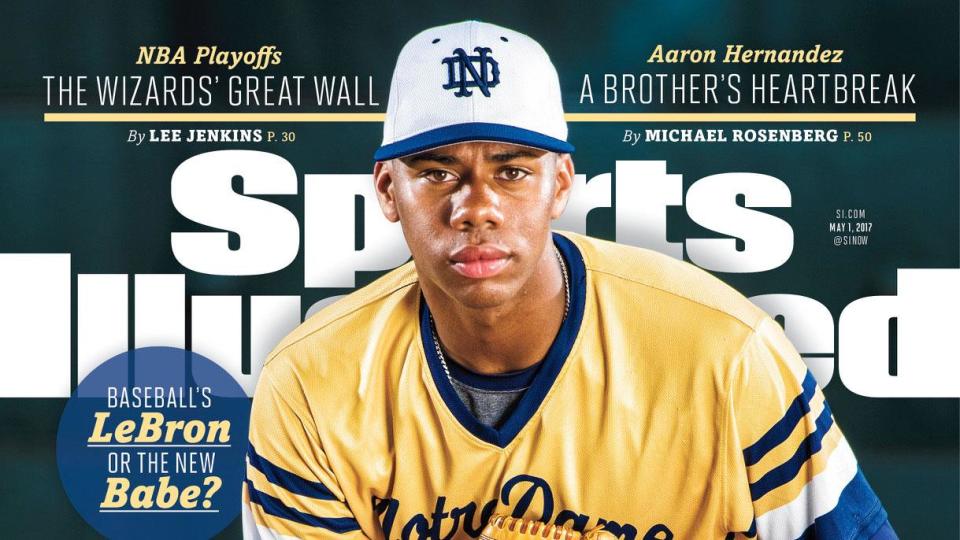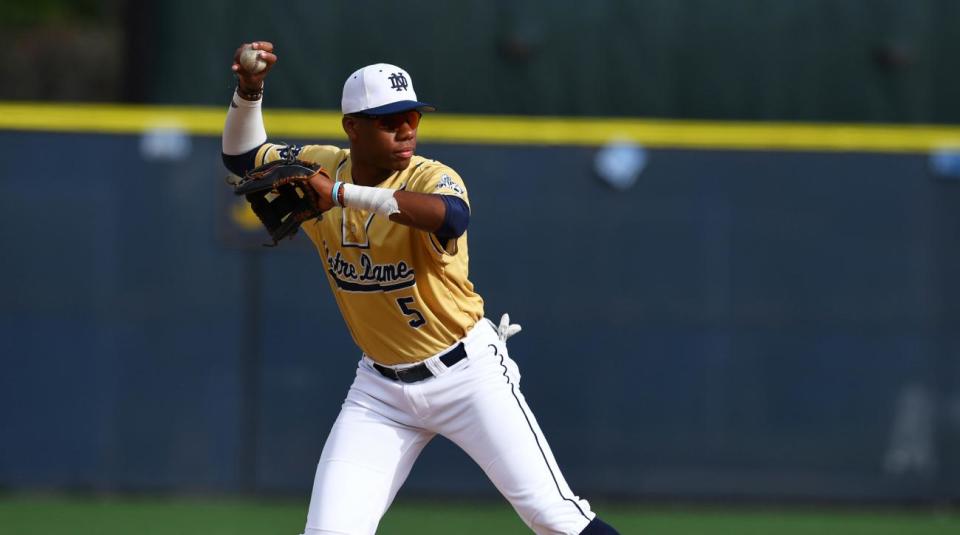Meet Hunter Greene, the 17-year-old who could be baseball's LeBron James
Baseball generally isn’t the sport where everybody knows the names of the hottest prospects months and months before the amateur draft. But there’s a good chance between now and June 12, you’re going to hear a lot about Hunter Greene, a 17-year-old star from Giancarlo Stanton’s old high school who just joined some rather elite company.
[Sign up for Yahoo Fantasy Baseball: It’s not too late to get in the game]
On Tuesday, he became just the 13th prep athlete to make the cover of Sports Illustrated, joining the likes of LeBron James, Bryce Harper and Kevin Garnett as youngsters with enough high-school hype for a cover spot. Making the cover of Sports Illustrated doesn’t guarantee prolonged professional success — just ask basketball player Sebastian Telfair or Jon Peters, a Texas hurler who made the cover in 1989 and was the only high-school pitcher to do so until Greene did. Peters never even played pro baseball after arm injuries derailed him in college.
There’s about a 99.9 percent chance that you hear Greene’s name on draft day and a pretty good chance he could go No. 1 overall to the Minnesota Twins. If not there, then No. 2 to the Cincinnati Reds. He’s also committed to UCLA, though the big leagues could beat out college.
It’s not hard to understand why once you hear the things Hunter’s able to do at Notre Dame High School in Sherman Oaks, Calif.: hit 450 foot homers in the batter’s box, throw 102 mph from the pitcher’s mound. It’s enough that Sports Illustrated wondered whether he’s “baseball’s LeBron or the new Babe?”
He could also be the type of star the attracts a new generation to the game, if both he and MLB play their cards right. Lee Jenkins of Sports Illustrated writes:
“This is exactly the kind of kid we desperately need,” says one major league official. Greene is African-American, arriving at a time when baseball grapples with a dearth of African-American players. At six he started wearing Jackie Robinson’s number 42. At seven he talked with Dan Rather for a piece on AXS-TV about race and his chosen sport. At 13 he won an essay-writing contest that earned him a meeting with Robinson’s daughter, Sharon.
Last year he ate lunch on Ventura Boulevard with pal Dave Winfield to discuss the future of baseball. And last month he threw out the first pitch on Opening Day at Ladera Little League, situated in a predominantly African-American neighborhood. After his speech (“Your children are not being drafted today,” he cautioned the parents. “Ice cream after the game always works”), Greene stood at the bottom of the mound on the Majors field, tears under his Aviators. “I get it,” he said, in reference to the responsibility he is about to inherit.
Beyond that, he’s a flat-out interesting kid — a new-age teenager who paints, plays violin, listens to Travis Scott and is learning Korean. For a 17-year-old, he’s already done and dealt with a lot beyond baseball. His younger sister Libriti was diagnosed with leukemia when he was 10 and she was 5. Greene would sleep in the hospital with his sister, going directly from there to baseball tournaments.
When Libriti’s disease went into remission, Hunter would return to the hospital to help prepare food for Thanksgiving or wrap presents at Christmas. He also started a sock drive last winter for the homeless in L.A. and spoke on a panel at last year’s All-Star game about limiting arm injuries for young pitchers. He might already be one of the most interesting people in baseball — and he hasn’t even been drafted yet.
The next big question about Hunter is what to do with him on the baseball field. Is he a pitcher? Is he a shortstop? Is he some combination of both that baseball hasn’t yet wrapped its head around? Writes Jenkins:
One way or another, Hunter Greene is probably on the precipice of history, either as the first righthanded high school pitcher ever taken with the top pick, or something else entirely. “I’m not sure what that would even look like,” says an executive with a team selecting early in the upcoming draft. “But I do think it’s worth having the conversation.” Front offices are already in the midst of similar discussions about another tantalizing two-way star, Japanese sensation Shohei Ohtani, starting pitcher and designated hitter for the Nippon Ham Fighters.
But Greene’s glove introduces another element. According to [Alan] Jaeger, an arm-care expert who has consulted for eight organizations, trying to pitch and play shortstop in the pros is borderline dangerous. “There’s a cycle of starting pitching that requires a five-day regimen of recovery and buildup,” Jaeger explains. “You can’t just go out there the day after you pitch, or the next day, and throw across a field with aggression. But I’ll tell you what is possible for someone like this: He could be a closer and a DH, and he could do that very safely.”
No matter which position he ends up playing for which team, it’s pretty clear at this point that we’re going to be hearing a lot more about Hunter Greene in the years to come.
– – – – – –
Mike Oz is the editor of Big League Stew on Yahoo Sports. Have a tip? Email him at mikeozstew@yahoo.com or follow him on Twitter! Follow @MikeOz
More from Yahoo Sports:
• The final 2017 NFL mock drafts from Yahoo Sports
• Gregg Popovich leaves massive tip on $815 bill
• Rockets advance, but Westbrook is the story again
• Tim Brown: Why we shouldn’t slam unlikely MLB slugger




